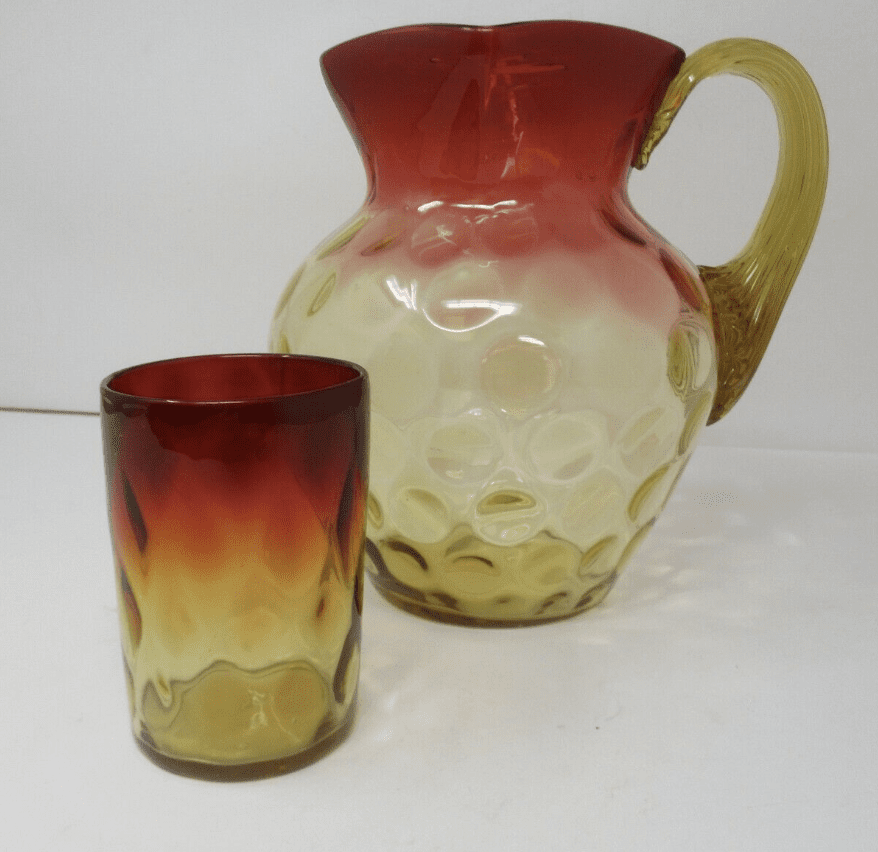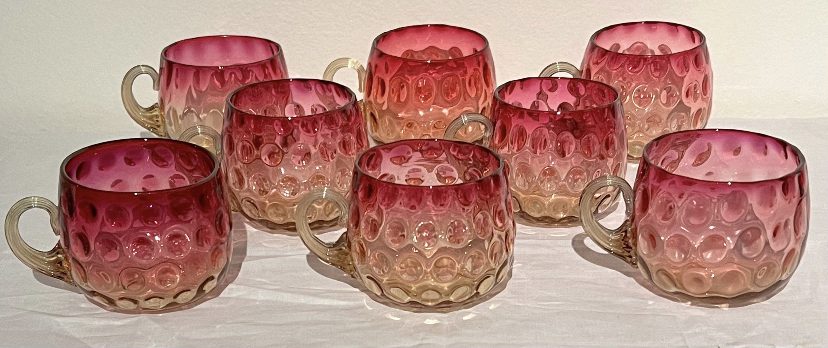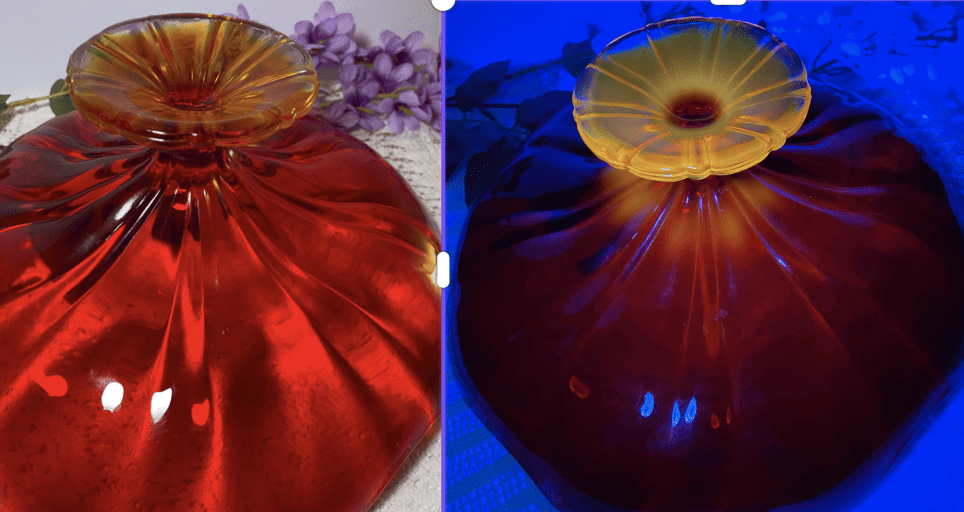You’ve likely seen amberina glass in your search for collectible glass as its distinctively beautiful colors set it apart from other art glasses. But, be advised that there are a few fakes out there that can easily be confused with true amberina glass. We’ll explore how you can determine if a glass piece is true amberina glass.
Authentic amberina glass will present a smooth fade of colors, typically from deep ruby red to amber or yellow. The color variations of amberina glass are created by reheating and cooling techniques. True amberina is never “painted on” coloring and is never a solid color.
Let’s look at what makes amberina glass…amberina glass! There are many interesting techniques and features of amberina that make this a fascinating type of glass to learn about and collect.

Is Amberina a Color?
Yes, amberina is a color of glass. It can be compared to a “sunset” gradation of color: rich ruby, blending into a deep yellow or amber shade. Some amberina is referred to as reverse amberina with the gradation blending from deep yellow or amber down to the rich ruby.
Many manufacturers produce amberina, but some create amberina that is considered “fake” amberina, which is something you’ll need to look out for in searching for collectible amberina glass.

Another type of amberina doesn’t feature the ruby color but instead a blue color in its place. This is referred to as blue amberina or bluerina. Bluerina is a rare find in amberina glass, and prices for these pieces are typically much higher than for traditional amberina glass or reverse amberina glass pieces.
Does Amberina Glass Glow?
Not all, but some amberina glass can glow! You can check this by shining a UV/black light on your amberina pieces and some of them may glow a vibrant shade of orange, yellow, and red. There aren’t any resources that provide information as to whether bluerina glass pieces glow. Many pieces do not glow but will still look nice illuminated by sunlight or by indoor lights such as those found in curio cabinets. A quick Google search can provide some beautiful examples of glowing amberina glass.

To find out if a piece of amberina glass glows, you can check this by shining a UV/black light on your amberina pieces and some of them may glow a vibrant shade of orange, yellow, and red. UV flashlights are available for purchase and are easy to travel with, making them the perfect item to take with you to check for UV reactivity in amberina on the go.
You may also come across Carnival glass that glows. Carnival glass was sometimes produced in an amberina shade, which created an extremely striking appearance. Carnival glass is already a masterpiece of a collectible with its rainbow of iridescent colors, but combined with amberina glass, these are exceptional collectors’ pieces that will surely get a lot of questions and compliments when shown in your collection.
What makes Amberina Glass Glow?
Amberina pieces that have cadmium mixed with sulfur (to form cadmium sulfide) and selenium will be UV reactive. Cadmium is what makes the glass UV reactive. Some pieces of amberina are created with only selenium and will not be reactive to UV light. Selenium produces a pink or orange glow in UV light while cadmium will glow either yellow, pink, orange, or a red color.
Over the years, manufacturers have experimented with this form of creating amberina glass, but during the early years of the twentieth century, there was a shortage of selenium to create this glowing glass. By 1917 however, supplies were once again available for creating remarkable glowing glass pieces. The majority of glowing pieces of amberina glass were created around this time period, although late-manufactured creations can be found.
Is Amberina Glass Painted?
True amberina glass is not painted. An amberina technique that is painted onto glass is considered fake amberina. While these pieces will look very similar and beautiful in appearance, please note that over time painted amberina will start to show its true colors (pun intended).
The paint will start to chip off, revealing clear glass underneath. The end result is a clear glass piece with chipping red and amber paint, not a very attractive look. Older fake amberina is easy to spot because when pieces have paint that begins to chip, it tends to chip quickly and shows a lot of the clear glass underneath the façade.
Authentic amberina pieces will not show any signs of paint on the surface. The color of the piece will be uniform with deep shading, and the color gradation will be a smooth transition in appearance. The colors will blend seamlessly into a fade that looks very similar to a sunset.

Another way to identify amberina is by looking at the transition or fading of the colors. The colors will fade seamlessly into one other, while pieces that are painted may have a color gradation that appears wavy, uneven, or unblended. It is much more difficult to create an authentic amberina piece than it is to create one with paint. The blending of glass colors takes time, patience, and skill to create the perfect fade and finish.
What is Reverse Amberina Glass?
As we discussed earlier, reverse amberina glass features the same colors as amberina glass, but the shades are reversed. In reverse amberina, the ruby shade will be near the bottom of the piece while the yellow/amber shade is on the top of the piece.

Reverse amberina is just as stunning as traditional amberina glass. You need to be careful in looking for these pieces as well: reverse amberina fakes with chipping paint can also be found in this color scheme.
It seems that reverse amberina is much more difficult to find, which means that if you come across any reverse amberina, you should add those to your collection!
This color combination is not as rare as bluerina but is not spotted as often as traditional amberina pieces. You can imagine what this color scheme looks like by imagining a sunset basically turned upside down.
Check out our article to learn more about the history of amberina glass.

